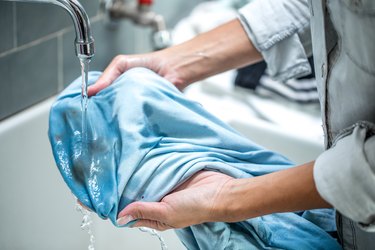
Seeing sun stains on your favorite clothes can be dispiriting and upsetting, and you may wonder how to reverse the damage on sun-bleached clothes. This can be an especially pertinent issue with vintage fabrics, including clothing and other textiles, such as furniture or rugs. While there are some measures that can be effective in a limited number of scenarios, the best cure in this case is prevention. Understanding what causes sun stains and how to minimize sun damage will help you preserve your clothing and textiles.
Causes of Sun-Bleached Clothes
Video of the Day
Fading damage caused by the sun can be due to heat, direct light or ultraviolet (UV) radiation. UV radiation is responsible for about 40 percent of fading damage. A drive toward environmental awareness has caused many manufacturers to abandon harmful solvent-based dyes and return to water-based dyes, which are more prone to fading in sunlight. This is also why vintage clothes and textiles are more prone to sun fading: They were made with older, less stable dyes.
Video of the Day
Finally, even indoors, there has been an increasing trend of exposure to natural light, as large windows have become cheaper and more energy efficient. These three trends have caused an increase in fading in clothing and other textiles in recent years.
UV Radiation Is Harmful to Dyes
The color a fabric appears to us is due to light-absorbing color bodies in the dye called chromophores. They absorb all the wavelengths of visible light and reflect only the intended color of the dye. UV radiation causes fading because it breaks down the chemical bonds in the dye, and the pigment loses its molecular attraction to the fabric. This fading process due to light is called photodegradation.
In addition to photodegradation from UV damage, heat can also cause sun stains in clothes. For this reason, it's important not to dry or leave clothes in bright, direct sunlight and to dry on the lowest feasible heat settings if using a dryer. Sunlight can also cause other forms of damage, such as embrittlement or cracking.
Preventing and Addressing Sun Stains
The best way to address sun stains is to prevent them from happening. There are a couple of common direct causes for sun stains in clothes. One is line drying in direct sunlight. While it's faster, may make the clothes smell and feel better and kills various types of germs, it's also likely to damage the clothes. Line drying in indirect sunlight or shade will take longer but is less likely to cause damage.
Another common cause of sun stains that may be surprising is the way they are hung on a clothes rack. On older garments or if your clothes rack is exposed to light, you may notice a stripe of sun stains along one side. This is caused by the very edge of the hanging garment being exposed to light. For this reason, you should always close your closet doors or cover an open closet to prevent light from entering.
More Sun-Stain Prevention Tips
Another tip is to always treat sets or matching pieces the same. Wash and dry them together, store them together and wear them together. This way, they will get the same amount of exposure.
Choosing fabrics and colors that are less likely to fade in the first place is also a good idea. If possible, avoid linens and silks, which are prone to fading quickly. Instead, opt for natural fabrics, such as cotton and wool or wool blends. Certain synthetic blends with nylon, polyester or acrylic can also be fade-resistant.
Darker colors fade more quickly than lighter colors, with red fading fastest of all, followed by black. However, with all-black fabric, there is at least some recourse, which is typically not the case with reds.
Removing Sun Stains
If a garment does get sun damaged, it's tempting to try to dye it to return the color. However, in most cases, this will not work. The dye will dye everything relative to its starting point, so the nonfaded areas will come out darker, and the bleached areas will still be lighter, and different fabrics (such as the stitching thread as opposed to the main body of the fabric) will take the dye differently. A professional may be able to carefully apply dye selectively to address sun stains, but a less expensive fix may be to simply add embellishments, such as appliques, to stained areas to cover them.
However, if the faded garment is all black, you can try applying coffee as a dye. Brew two to three cups of the darkest-roast coffee you have and set the faded black garment in a cold-water rinse cycle in the washing machine, making sure not to use detergent.
Add the coffee as the water starts to fill the washer. Let the cycle run and then run the garment on a cold-water delicate cycle with detergent. The black clothing should be significantly restored.
- The University of Central Florida Solar Energy Center: UV Transmittance and Fading
- Library of Congress: Why Does Ultraviolet Light Cause Color to Fade?
- Embassy Cleaners: What Is Color Fading and Can It Be Prevented?
- A Cleaner World: How to Prevent Color Fading from Sunlight
- Airows: Revive Faded Black Clothing With This Easy Life Hack